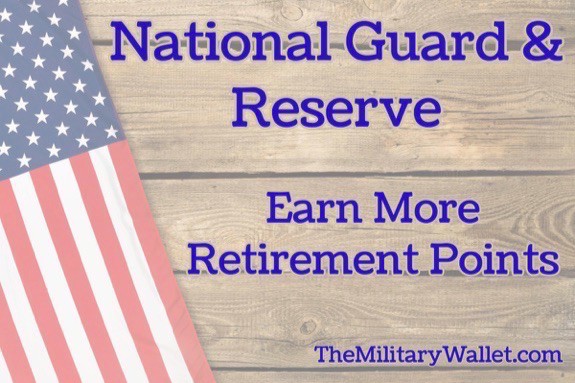Podcast: Play in new window | Download
Subscribe: Apple Podcasts | RSS
The Guard and Reserve retirement system differs greatly from the active duty retirement system. Instead of rewarding servicemembers with retirement pay based on the number of years served, Guard and Reserve members are awarded Points based on their service. The more Retirement Points one earns, the larger the retirement pay. Understanding the Guard and Reserve Point system is essential for understanding how and when one will be eligible to retire and how much one will earn in retirement.
We have an in-depth Guard and Reserve Retirement Points Guide that explains what Points are, how they are earned, how many Points you can earn in a given year, and other important information. I highly recommend reading the guide if you are in the Guard or Reserves. It will help you better understand the Points system and hopefully open some doors to earning more Points toward retirement.
In today’s article, we will cover how you can earn more Points to boost the value of your retirement.
Table of Contents
- Retiring Soon and Wanting to Earn More Retirement Points
- How to Earn More Retirement Points Before Retiring
- 1). Retirement Points 7-Level Training (Upgrade training, for other branches of the military):
- 2). Earning Points for Correspondence Courses:
- 3). Earning Point Credits for Correspondence Courses:
- More Ways to Earn Retirement Points:
- Apply for orders (Active Duty, IMA, TDY, deployment, etc.)
- Try to serve additional Drills or AT Days
- Serve in the Honor Guard for Military Funerals
- Take more correspondence courses (if available)
- Advanced method for earning more Points – Front-load your annual Drills and Training days
- Stick around another year (or longer)
- Transfer into the IMA
- There Are Limits to the Number of Points You Can Earn Each Year
- More Points = More Retirement Pay, But Don’t Stress Out About It
Retiring Soon and Wanting to Earn More Retirement Points
We frequently receive reader questions, and the following is a recent example. I try to answer every question personally, but sometimes, it also makes sense to share the question and answer with a larger audience. Increasing the number of Retirement Points earned is something that applies to all members of the Reserve Component, so it makes sense to share this with everyone.
Here is the reader question (note: the specifics of this question apply to the Air Force Reserves, but the answer can be applied to members of the Guard or Reserves, and all service branches).
Hi Ryan,
Thank you for your informative article. I know that retirement pay is a hot topic these days. I’m getting ready to retire at the end of the year myself, and have a question, but something else I read in a comment sparked another one.
1) I do not see retirement points in the ECI column on my Point Credit Accounting and Reporting System (PCARS) for my 7-level upgrade training in my previous AFSC (3S0X1). I do see retirement points in the ECI column for my current AFSC. Does certain 7-level coursework count towards retirement points?
2) Do any correspondence courses taken on the Air Force IT e-learning site count for retirement points? I saw a comment you made to another individual that indicated that the Army e-learning courses counted for retirement – something like 1 point for every 3 hours, or something.
3) If these correspondence courses do count, how do I go about getting them added to my PCARS statement?
Thanks! I am a point hound. My goal was to retire with 4000, but I am coming up short by about 150. I have over 100 correspondence courses I had to take for my AFSC (3D0X1), and if I can translate them into points, I might make my goal!
Thanks, MP
How to Earn More Retirement Points Before Retiring
Hello MP,
Thanks for reaching out. This is a great question. I don’t have specific answers to all your questions, but I’ll do my best, then move on to other ways you can earn retirement Points before dropping your paperwork and applying for your Retirement Letter.
Again, these are the answers to the best of my knowledge. Please note that I don’t work in personnel, so please verify everything before filing your retirement papers. Remember, the best time to make corrections is before retiring!
1). Retirement Points 7-Level Training (Upgrade training, for other branches of the military):
I don’t know if every 5-level and 7-level course awards Points for completing the Career Development Course (CDC) end-of-course test or being awarded the rating. I recently cross-trained into a new career field and was awarded 12 Points upon passing the end-of-course CDC test. There was a statement at the front of the CDC course volumes that stated the course was worth 15 Points (I was awarded 12 Points instead of 15, so perhaps the number of Points changed from when I was issued the volumes). See if you can find a copy of your old CDC volumes and look inside the front cover to see if there are any Points awarded for completion of the end-of-course test.
You should also check with your Personnel or Education & Training section to verify this. They should be able to help you apply these Points if they should have been applied upon passing the CDC end-of-course test.
You must be in Reserve status to earn Points for correspondence courses:
Note that training completed while on active duty wouldn’t earn additional Points credit—that would be double-dipping. You can only receive Points if you take the end-of-course test or complete other training while in Guard or Reserve status.
Members of the other service branches should verify with their appropriate agency whether their upgrade training is worth Retirement Points.
2). Earning Points for Correspondence Courses:
Some correspondence courses, but not all, count toward Retirement Points. Most military branches will award credit for certain Professional Military Education (PME) courses required for promotion or career advancement.
For example, the Air Force will give Point credit for members who complete Distance Learning versions of required PME courses such as Airman Leadership School, the NCO Academy, the SNCO Academy, and similar courses. (Again, one must be in Reserve status to earn Points for the correspondence courses – you cannot earn additional Points for taking correspondence courses while in active duty status).
I don’t have a full list of correspondence courses that earn Points credit – this would be behind the CAC card paywall, and honestly, I’m not sure where it would be located. I would speak with your Personnel or Education & Training sections to see if they have a list of approved courses for Point credit.
From what I have read and heard through the grapevine, there aren’t many correspondence courses that award credit. And if it’s like the other service branches, I expect the number of courses to decrease over time. For example:
- Army Correspondence Courses and Point Credit: The Army recently stopped accepting correspondence courses for Retirement Point credit: “Military correspondence non-residential distance learning retirement point credit (1 retirement point per every 3 hours) was removed as a form of retirement point credit effective 15 April 2016.” (source).
- Navy Correspondence Courses and Point Credit: The Navy has reduced the number of correspondence courses available for Point credit. They are also limiting correspondence courses to members with a CAC card – effectively making it impossible for many members of the IRR to complete correspondence courses for Point credit.
- US Marines Correspondence Course Point Credit: I haven’t heard of any changes to this program, but I will be happy to update this resource as new information becomes available. Marines can earn credit for taking courses through the Marine Corps Institute Distance Education Courses (MCI’s) as well as Marine Net Courses. Here is a USMC correspondence course reference.
- Air Force Correspondence Course Point Credit: I can’t find any publicly available information for which courses are accepted for credit.
3). Earning Point Credits for Correspondence Courses:
The best thing to do is to bring a copy of your transcript or certificate of completion to your Personnel or Education & Training section. They can point you in the right direction or help you apply the credit for approved courses. You should do this as quickly as possible for two reasons:
- Some transcripts may take some time to process, both on the sending and receiving side.
- Your branch of service may limit which courses are accepted for credit, or, like the Army, they may stop accepting correspondence courses for Point credit.
More Ways to Earn Retirement Points:
You’re very close to your 4,000-Point goal. But I wouldn’t let your goal of retiring at the end of the year stop you if you are set on retiring. 3,850 Points is still very good and is equivalent to over 10.5 years of active duty service (10 years is 3,600 Points). But there may be other ways to increase your Point total before your proposed retirement date.
Apply for orders (Active Duty, IMA, TDY, deployment, etc.)
Orders will earn you 1 Point per day served. Availability will depend on your career field, unit needs, and other factors. Bonus: deployment orders over 90 days can help Guard and Reserve members retire early.
Try to serve additional Drills or AT Days
Many units have additional service opportunities that you may qualify for. Ask around your unit to see if there are any duties you can fill. The number of Points you can earn through inactive duty cannot exceed 130 Points (see the section below for more info about limits on Points). This will include your Drill Days, AT Days, correspondence courses, Honor Guard for funerals, and other methods of earning Points while not on active duty status.
Serve in the Honor Guard for Military Funerals
Honor Guard members earn 1 Point each day they participate in Military Funeral Duties. This is typically unpaid duty (unless you are on active duty orders). But it can be a good way to serve and earn additional Points. It’s also one of the most humbling ways we can honor our military brethren one last time.
Take more correspondence courses (if available)
We have already covered this topic – but it’s worth addressing again. Some courses may be available. So do your research and make sure you understand what is required to earn Points. Keep in mind most correspondence courses do require a substantial amount of work in order to receive credit. So, this isn’t necessarily a quick way to earn a massive amount of Points.
Advanced method for earning more Points – Front-load your annual Drills and Training days
Some units may allow you to front-load your Drills to earn credits more rapidly. If you are retiring, check with your unit to see if you can serve a full year’s worth of drills and Inactive Duty Training (IDT) days in a couple of months time frame before applying for retirement or transferring to the IRR. This allows you to earn a full year’s worth of Points in a short time frame.
Again, not all units will do this, but it’s worth asking if you can spare the time away from your day job. (Bonus: you also get the 15 Annual Participation Points if you cross into a new service year). Some Reserve members use this strategy before transitioning into IRR or retirement status. This allows them to earn an additional Good Year of service and add Points to their total.
Stick around another year (or longer)
Crossing over your anniversary date earns you an additional 15 Annual Participation Points if you complete the entire year in the Reserve Component. By itself, 15 Points won’t be enough to earn a Good Year. But that won’t matter if you already have enough Good Years to qualify for retirement benefits.
You could also do what was mentioned above and stick around past your anniversary date, then try to front-load your Drills and AT days. You only need to earn an additional 35 Points above the 15 Participation Points to earn a Good Year. Just be sure to transfer into the IRR to complete the full year of service so you don’t miss out on the Good Year and/or the full 15 Annual Participation Points.
Transfer into the IMA
The Individual Mobilization Augmentation (IMA) program is part of the Reserves. Members earn the normal 15 Annual Participation Points as a member of the IMA, but they don’t serve the standard weekend drill schedule. Instead, IMA members fill in to “augment” when and where they are needed.
The benefit of transferring into the IMA is being able to batch your service days and serve your entire year’s obligation into one or two periods instead of serving the traditional “one weekend a month, two weeks a year” schedule (this is very similar to the front-loading mentioned above). Another bonus is that many IMA members can pick up more duty days if they are willing to volunteer and put in the time. Third bonus: Some IMA duties are located in prime overseas duty locations – which makes this a fun way to travel on the government’s dime and mix business with pleasure.
Not all career fields or ranks are eligible for IMA duty, so check with your parent human resources agency for availability and more information. Here is an Army IMA Frequently Asked Question page for more general information about the program.

Check your VA Home Loan eligibility and get personalized rates. Answer a few questions and we'll connect you with a trusted VA lender to answer any questions you have about the VA loan program.
There Are Limits to the Number of Points You Can Earn Each Year
There are two limits to be aware of when looking at the total number of Points a member of the Reserve Component can earn in any given year. The first is the Point limit for inactive duty; the second is the total Point limit.
The total maximum is 365 Points (366 in a Leap Year). This is equivalent to a full year on active duty service (even if the time is mixed between active duty and Reserve time). It is not possible to exceed 365 Points (or 366 in a Leap Year). In other words, you cannot earn 365 Points in a given year and then also take various correspondence courses or Military Funeral Honors duty to exceed the upper limit.
Points Limit for Inactive Duty: By law, there is a cap on the number of inactive duty points that can be accrued for retirement in a given year.
- Reserve year ends on or after 30 Oct 2007: max of 130 Points
- Reserve year ends on or after 29 Oct 2000: max of 90 Points
- Reserve year ends on or after 23 Sep 1996: max of 75 Points
- Before 23 Sep 1996: max of 60 Points
These limits apply to all branches of the military.
More Points = More Retirement Pay, But Don’t Stress Out About It
While it’s true that more Points = increased retirement pay, there is a point of diminishing returns. Earning more Points usually means an increased workload and increased time away from your family and your civilian job. These can negatively impact you if you don’t find the right balance.
Find your balance. I love serving in the Guard. But I also love my time with my family. Each volunteer assignment takes me away from them and away from my business. Most people have similar constraints on their time and energy.
Once you reach 20 Good Years of Service, you must balance continued service with the opportunity cost of Retiring Awaiting Pay. This is also true for those of us who haven’t reached 20 Good Years of Service.
How much are Retirement Points worth? This is a great question, and it varies for each individual and is based on their rank and time in service. The Guard and Reserve Handbook has a Retirement Points chart that shows how much each Point is worth based on your pay scale. Use that chart to help you determine how much you need those additional Points.
Did I miss anything?
As you probably know, Retirement Points can be a complicated topic. Some rules apply to all servicemembers, then there are additional rules that may apply to members of certain branches, different programs for Guard members and Reserve members, etc.
I’ve done my best to cover everything, but I’m unfamiliar with every possible scenario. So please drop me a line or leave a comment below if I missed anything. I’ll be happy to update this article to reflect that information.




Comments:
About the comments on this site:
These responses are not provided or commissioned by the bank advertiser. Responses have not been reviewed, approved or otherwise endorsed by the bank advertiser. It is not the bank advertiser’s responsibility to ensure all posts and/or questions are answered.
C Trout says
Great information to share with G/R folks I know. I heard there is a way to get points (not pay) for volunteering with ESGR. How exactly does that work?
Robert R says
Great article! I have a question on the total maximum retirement points allowed at the end of your service. I have over 10,000 points that follow the guidelines as you stated in your article. Will all over them be counted towards my retirement pay or is there a cap on points? Where is it located in the regulations?
Jonas says
For USAFR and ANG here is the latest on points awarded for AWC 18. Gotta have a CAC, so straight IRR will be unable to get these (Gotta be PIRR, IMA, or SELRES).
Air War College
3 Orientation GSS700S
15 Elective (choose 1 of 4: joint planning WAR707S, negotiating WAR705S, coercive airpower WAR701S, cross-culture comms WAR704S)
5 International Security ISS700S
6 Airpower and National Strategy AIR700S
8 Applied airpower and security AIR701A
5 Strategic Leadership LDR710S
5 Senior Leadership LDR711S
8 Applied Senior Leadership LDR712A
10 Focused Studies (choose 1 of 6: AFRICOM NSP810A, CENTCOM NSP820A, EUCOM NSP830A, NORTHCOM NSP840A, PACOM NSP850A, SOUTHCOM NSP860A)
Jonas says
For USAFR and ANG here is the latest on points awarded for ACSC 7.0. Gotta have a CAC, so straight IRR will be unable to get these (Gotta be PIRR, IMA, or SELRES).
ACSC
0 Orientation ORN-601S
1 Critical Thinking GSS-601S
4 Leadership and Command I LDR-601S
3 Leadership and Command II LDR-602A
4 National Security Decision Making ISS-601S
2 Warfare Studies WAR-601S
3 Making Decisions: Strategy and War ISS-602A
3 AF Core Missions AIR-601S
3 Airpower in Joint Ops AIR-602S
3 Joint Fundamentals JNT-601S
4 Joint Airpower in Warfare AIR-603A
3 Joint Planning: Context and Strategy JNT-631S
3 Joint Planning: Art and Science JNT-632S
3 Joint Planning: Process and Application JNT-633S
4 Joint Planning Facilitated JNT-634A
9 Focused Studies (choose 1 of 7 areas. Each area has 2 to 3 individual courses of varying point values, but whichever area adds up to 9 points)
Adam says
Were the points automatically awarded after each course? Thanks for the info!